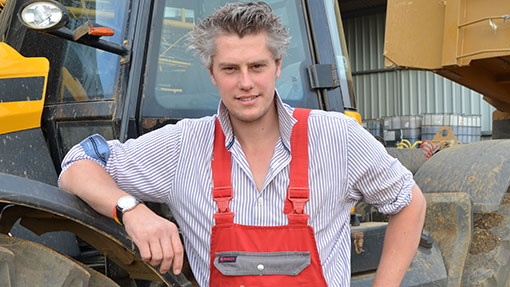Driver’s view: JCB Fastrac 4000 tractor

One prototype Fastrac has racked up almost 500 hours in just a couple of months on a farm near Ely. Nick Fone finds out how it has performed on the road and in the field.
PJ Lee and Sons is a big operation. Covering 2,630ha (6,500 acres), the business produces more than 40,000t of potatoes every year, mainly for fish and chip shops across the country. Land is spread across a 40-mile radius so tractors spend a lot of time on the road.
“To us, transport time is dead time,” says Andrew Lee (pictured). “If we can minimise the amount of time our machines are on the road and maximise their time in the field, we’re becoming more efficient.”
The firm now runs four JCB 2170s, which clock up between 1,000 and 1,700 hours every year. After planting, they quickly move on to irrigation duties that involve moving 40 booms and reels every day.
Farm facts
- PJ Lee and Sons, near Ely, Cambridgeshire
- Farmed area: 2,656ha (6,564 acres)
- Cropping: Wheat, sugar beet, maize and potatoes, rented out land for onions, red beet, carrots, leeks and turf
- Soils: Predominantly peat Fenland soils
- Machinery: Tractors – 3 x John Deere 6210Rs, 6 x 6150Rs, 1 x 8365R, Caterpillar MT845-D, 4 x JCB Fastrac 2170s, plus up to 36 extras hired in as required. In reserve – Ford TW20, 7840SLE, 7810 Jubilee, 2 x 35X Track Marshall 55s
- Sprayers: 2 x 5,000-litre Mercedes Benz S-Tracs with 36m booms, 5,000-litre Challenger RoGator and 4,000-litre John Deere 840i trailed
- Loaders: JCB 535-95 plus another three hired in as required
- Combines: Claas Lexion 780 Terra Trac
- Potato kit: All Grimme – mix of self-propelled and trailed harvesters
- Sugar beet harvester: Holmer self-propelled six-row row tanker T3
- Staff: 22 full-time, 10 self-employed plus another 70-80 seasonal part-time
Having that extra road speed enables the Fastrac operators to do at least one extra move a day compared with their colleagues on conventional tractors. And it is the same story when on bowsering duties for the sprayers.
Hard work
Because of this varied workload, the Lees’ farming operation was seen as an ideal place to test a prototype version of JCB’s new 4000-series Fastrac. It arrived in August and has since clocked up some 411 hours. It came straight off the wagon and on to a three-leg Simba sub-soiler working at 400mm (16in) pulling up heavily compacted tramlines.
“We were expecting to need a rear deck weight, but with just 850kg on the nose, the tractor pulls incredibly well – there’s no scrapping around on top.
“And it’s the same story on the trailers. With a 16t Larrington hitched up, it digs in, grips and pulls. And, because it’s a Vario there’s no loss of speed or traction for gear changes.”
Next generation
The Lees were involved with the project from the beginning and back in 2010 were asked by JCB for their thoughts on what the next generation Fastrac should look like.
“We wanted JCB to retain the Fastrac layout but we find the 2000s are limited on power and so that was one area that needed addressing.
“The cab needed changing, too – it lacks storage and just feels claustrophobic. But, most importantly, the gearbox had to change – for fieldwork you were never in the right gear. And that’s all been sorted.”
Down time
Mr Lee’s previous experience testing prototype machines for other manufacturers meant he expected plenty of downtime, but the 4220 that’s been on farm this summer has suffered relatively few issues, with just a small oil leak and a pin that dropped out of the hand-brake linkage.
“Running the tractor sometimes 24 hours a day hauling potatoes makes you realise how much better the new suspension is – there’s none of that lumpiness you had with the old coil-spring setup.
“But it’s the lugging ability that really impresses me. Having a stepless box means there’s no hunting up and down the revs – it just gets on and pulls.”
The cab gets a thumbs-up, too, although there could be more fixing points and the ability to integrate a range of different GPS steering systems would be ideal.
“The new tractor is a huge step up. Where we currently run four Fastracs, next year it’ll be five,” says Mr Lee.
“And, given how well the new one has performed and the distances we travel, I can’t see any reason why more of the fleet won’t become yellow.”
Farmers Weekly was at the launch of the first Fastrac in 1991. See the prototype at work below

